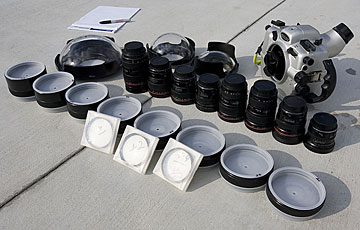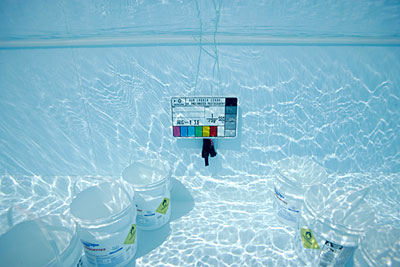Lens testing and port matching for Seacam housings by Stephen Frink
A few months ago I decided it was time to find out what would be optimal underwater performance of my particular lenses in my particular dome ports. So, that meant the tedious trial and error of pool testing with a variety of lenses, ports, port extension, and diopters. I even borrowed some lenses from Canon Professional Services to test a few lenses I did not own. Shown here are:
- Canon EOS1DsMKII
- Seacam housing with wide port, fisheye port, and superdome (S45 viewfinder)
- Port extensions from PVL25mm through PVL55mm
- +1, +2, and +4 diopters
- Canon lenses – 15mm, 14mm, 16-35mm, 17-40mm, 20mm, 24mm F-1.4, 35mm F-1.4, and 24-70mm zoom

My test procedure was to hang a weighted target in the center of the frame and use auto-focus to always focus on the interface of one particular color swatch. I set a tripod in the pool to always keep the same camera position, and I set the buckets on a diagonal to the sensor plane so that I could deduce at what point they fell out of focus in the corners. An assistant stood ready at poolside, dry, to change lenses and ports and keep detailed records.

While the results are perhaps only relevant to these particular ports and this full frame Canon digital camera, this is what I deduced:
15mm = superdome, no port extension * Note also that I have determined the 15mm is excellent with superdome, but performs relatively poorly in corners with fisheye port. On the other hand, both 10.5mm and 16mm Nikon fisheyes work perfectly with both superdome and fisheye port. Clearly, even though both Canon 15mm and Nikon 10.5mm are 180 degrees, there is a difference in the optical formula.
14mm = PVL25 and superdome, but still not wonderful in corner. Very difficult lens to get good performance underwater. Further in-water testing confirms ongoing issues with this lens, underwater it is marginal with all tested ports and extensions. I regret that I can not make the 14mm work adequately underwater, as this is a beautiful angle of coverage with I would love to have available.
16-35mm = PVL30 and superdome. Add +2 diopter (according to subject)**
17-40mm = Super Dome, PVL30. Add +2 diopter (according to subject)**
20mm – WP, PVL30
24mm - Wide Port, PVL30
35mm – Wide Port, PVL35
24-70mm – Wide Port, PVL90,+2 diopter. With this lens the diopter required to get decent close-focus performance. Without diopter lens drops out of focus nearer than about 3.5 feet.
* Tests demonstrated a problem with my personal camera + 15mm lens. When same problem was evident with 15mm lens borrowed from CPS, both underwater and topside, I knew it to be a camera issue. The lens would look sharp in the viewfinder when focused AF, but point of focus would actually be about a foot behind the subject (backfocus). When using manual focus on the same target, both lenses would be sharp. So, it was an issue with the AF mechanism on the camera and it was sent back to Canon (along with both 15mm and 17-40mm lenses) for calibration. Images are now much sharper after return from Canon Professional Services.
I was concerned that tweaking camera at the wide angle end might be a problem for my 100-400 zoom, but I found that it seems to be better now as well. Clearly, it was an issue with my camera body.
** Tests conclusively proved that adding a diopter helped enhance the center point focus, and possibly even corner performance, on the 16-35mm and 17-40mm zoom lenses (when properly matched to correct port and port extension); but did so at the expense of wide-angle coverage. The stronger the diopter, the less wide the maximum angle of coverage. For some subjects, like schooling fish or reef scenics, this may be an advantage. For other subjects, like shipwrecks or diver interaction, this may be a disadvantage.
While some shooters have very strong opinions about the importance of diopters, I have come to the conclusions that with the Seacam system, and the two primary zooms used, 12-24mm for Nikon and 17-40mm for Canon, the addition of a diopter is determined not only by the port (wide port will need a diopter, superdome does not ‘require” a diopter) but also by the kind of subject to be photographed. If ultimate wide angle coverage and distance depth of field is important to the composition, the diopter will likely be counterproductive. If enhancing close focus is the point, the diopter may be a good idea. Consider diopters for these lenses and the superdome as specialty tools, with careful personal testing recommended.
Point of the story - These new cameras are ultra-sophisticated and reveal lens and port flaws we never knew existed before. Unlike the old days where we could simply jump in the water with a water-contact, corrected-for-underwater-use Nikonos 15mm or RS with a 13mm, digital wide-angle with housings is very challenging. The cameras and their lenses see the world topside as a flat plane, and our dome port housings see the world behind a curved virtual image. Getting the most out of our wide-angle lenses will require some personal testing and experimenting, at least now at the current state of the art. And even then, will likely not work well at maximum apertures. Working at F-8 and smaller is a good idea with most port combinations, which may mean using a slightly higher ISO setting, perhaps 200, on the digital camera.
My tests are ongoing, but now after a morning in the pool with meticulous testing and record keeping, I feel I’m closer to my personal solutions.